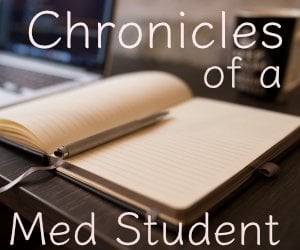Last Updated on June 26, 2022 by Laura Turner
I walked into my first rotation with a stethoscope and granola bar in my pocket and a LOT of nerves. I had no idea what to expect. I knew I had to impress my preceptor (which I imagined was easier said than done) and ace my shelf exam because this was the specialty I wanted to pursue. Talk about a lot of pressure. A fellow medical student and I walked into the hospital on the first day and while we were very obviously lost in the hallways, a tall man walks up to us and asks, “Are you looking for Dr. ___ ?” We slowly nodded our heads, still confused. He sticks out his hand and comments “well, you’ve found him.” So began our first day.
The rest of the day was amazing! Despite the fact that we had to figure out the logistics from who we would be working with to where to put our lunches, just being in the hospital made us feel so relevant. And coming from one of the most irrelevant members of the team (or so it feels as a third year medical student), this was saying something. We could finally put the long days in the classroom behind us as we stepped into the first day of the rest of our careers. This month, I would be on inpatient internal medicine, something I had been looking forward to. It is the bread and butter of medicine, and I could not wait to learn everything it entailed. Mastering this meant building a solid foundation for the rest of my medical career, regardless of which specialty I chose. As exciting as this revelation was, I realized during one of my first patient encounters that it is first and foremost about the patients.
 The first patient I talked to had been suffering from an exacerbation of chronic heart failure. He had on a bright smile under his nasal cannula and was trying his best to speak to me through short breaths. Though he struggled to talk, he looked me in the eye as he told me his story. As I listened, he grew more and more forthcoming about what was going on his life. He told me about how his family had been torn apart by tragedy a few months ago and that’s when he began to notice his symptoms. He also mentioned that no one else had taken the time to hear him out and how much he appreciated a listening ear. As a medical student, I have more time than almost every doctor or nurse to spend with the patient, so it’s critical that I listen to what the patients tell me. The information they provide me with may very well be the thing that leads doctors to the right diagnosis or treatment. I am embracing every moment I get to spend with them because they not only teach me how to be a better doctor, but also how to be a better person.
The first patient I talked to had been suffering from an exacerbation of chronic heart failure. He had on a bright smile under his nasal cannula and was trying his best to speak to me through short breaths. Though he struggled to talk, he looked me in the eye as he told me his story. As I listened, he grew more and more forthcoming about what was going on his life. He told me about how his family had been torn apart by tragedy a few months ago and that’s when he began to notice his symptoms. He also mentioned that no one else had taken the time to hear him out and how much he appreciated a listening ear. As a medical student, I have more time than almost every doctor or nurse to spend with the patient, so it’s critical that I listen to what the patients tell me. The information they provide me with may very well be the thing that leads doctors to the right diagnosis or treatment. I am embracing every moment I get to spend with them because they not only teach me how to be a better doctor, but also how to be a better person.
That’s why I entered medicine: to take care of people. Going through my first week on rotation reminded me of just that. On the first day of medical school, the first person we heard speak to us was a patient. She told us her experiences dealing with healthcare professionals and urged us to always think about the patients first. I have been waist deep in books, notes, exams, and various other things over the last two years, so I lost touch with why I was doing what I was doing: to treat people. It was very refreshing to be reminded of that and why medicine is considered both an art and science. Facts and science alone will not lead a patient to trust you or help you develop a relationship with them. The humanistic side is just as, if not more, important.
About the Author
Adelle is a 3rd year medical student who loves to hike, bake chocolate chip cookies, and doodle on the corners of papers.
Have feedback? Suggestions? Ideas for a column or someone to interview? Email [email protected].
Adelle is a 4th year medical student who loves to hike, bake chocolate chip cookies, and doodle on the corners of papers.

